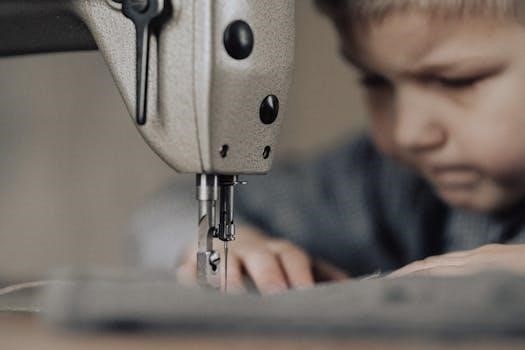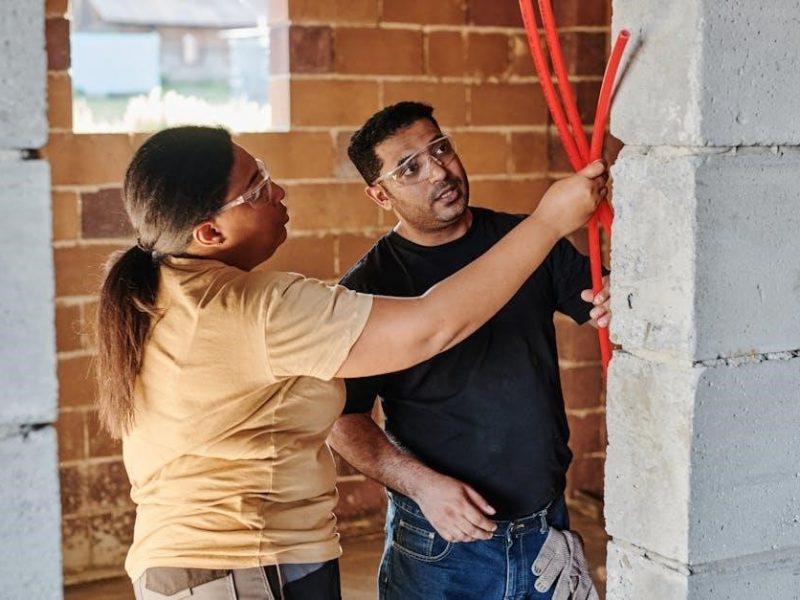Kenmore 12-stitch sewing machines offer versatility for various sewing projects. These machines, often models from the 385 series, provide a range of basic and decorative stitches. They are suitable for both beginners and experienced sewers, with many features to help users create projects with ease.
Overview of Kenmore Sewing Machines
Kenmore sewing machines, including the 12-stitch models, have a long history of providing reliable and accessible sewing solutions. These machines, often manufactured by other companies like Janome and sold under the Kenmore brand, are known for their user-friendly designs and durable construction. Many Kenmore models feature a full rotary shuttle, which contributes to smooth, even stitches. The “Ultra-Stitch” feature found on some models, such as the 158.1595, ensures uniform stitch quality. These machines often have a range of features, such as adjustable stitch lengths and widths, and some include a sew-by-color feature for easier stitch selection. Kenmore machines are available in both mechanical and electronic versions and are designed for a variety of sewing tasks, from basic mending to more advanced garment construction. Many users appreciate Kenmore’s combination of affordability and functionality. The availability of online manuals and parts makes these machines a popular choice for many sewing enthusiasts. They have various features which make them a suitable choice for a variety of sewing projects.
Significance of the “12 Stitch” Feature
The “12 Stitch” feature on Kenmore sewing machines is a significant aspect that caters to various sewing needs. These 12 stitches typically include a selection of basic and essential stitches, such as straight stitch, zig-zag stitch, blind hem stitch, and buttonhole stitch. These allow users to perform a wide range of sewing tasks, from basic mending and hemming to more creative projects like applique and decorative sewing. The “12 Stitch” models are designed to be user-friendly, making it easier for beginners to learn the basics of sewing while providing enough options for more experienced users to complete their projects efficiently. Having a selection of 12 stitch options means that the machine is versatile for a variety of fabrics and sewing applications, from lightweight cottons to heavier fabrics like denim. The 12 stitches are usually well-suited for common household sewing projects, and this selection makes these machines a practical choice for many home sewers.
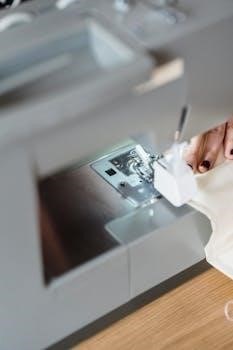
Understanding the Manual
The user manual is crucial for operating your Kenmore 12-stitch sewing machine correctly. It contains essential information on setup, threading, stitch selection, and maintenance, ensuring optimal performance and longevity of your machine.
Locating the Correct Model Number
Identifying the correct model number of your Kenmore 12-stitch sewing machine is crucial for accessing the appropriate manual and parts. The model number is typically found on a nomenclature plate, which is often located on the back, bottom, or side of the machine. This plate may also include the serial number. It’s essential to record both of these numbers for future reference when seeking manuals, replacement parts, or service assistance. For example, models like 385.12708, 385;12710, 385.12712 and 385.12714 are common series that utilize the 12-stitch feature. Similarly, models such as 158.1561180, 158.15951, and 158.1595180 may also be encountered. Accurate model identification ensures compatibility when downloading a manual or ordering accessories. Always double-check the nomenclature plate to avoid potential errors. The model number is the key identifier that helps distinguish your specific machine from others in the Kenmore lineup. Once you’ve located it, you can then proceed with locating the appropriate manual.
Key Sections of the User Manual
A typical Kenmore 12-stitch sewing machine user manual is divided into several key sections to guide users effectively. Initially, the manual often includes a setup section detailing how to properly install the machine, whether it’s in a cabinet, case, or on a flat surface. Threading instructions are another critical area, covering both upper and lower thread paths, as well as bobbin winding techniques. The manual will also dedicate sections to stitch selection and adjustment, often with diagrams for visual aid. Furthermore, it contains information on tension adjustments to achieve the best sewing results. Maintenance is a crucial section, highlighting cleaning and oiling methods to keep the machine running smoothly. Troubleshooting tips are usually provided to address common issues. Finally, some manuals may include parts diagrams, especially for identifying replacement components. It is crucial to understand the ‘Ultra-Stitch 12’ feature, as it is described in your manual, to properly use your machine.
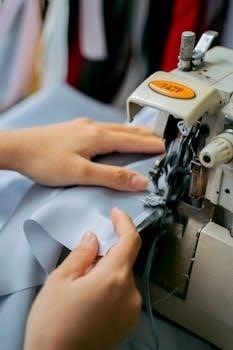
Operating the Kenmore 12 Stitch Machine
Operating the Kenmore 12-stitch machine involves several key steps, including setting up the machine, proper threading, and selecting the desired stitch. These steps help ensure smooth and successful sewing projects. Careful attention to the manual is essential.
Setting Up the Machine
Before starting any sewing project with your Kenmore 12-stitch machine, proper setup is crucial. Begin by ensuring that the machine is placed on a stable, flat surface, whether it’s a dedicated sewing table or a sturdy countertop. If using a Kenmore cabinet or case, ensure the machine is securely installed according to the instructions. Next, verify that the power cord is correctly plugged into both the machine and a functioning outlet. The machine has been oiled at the factory, but you should wipe off the needle plate area, bed plate, and bobbin case carefully to remove any excess before sewing. Practice on a scrap fabric piece to ensure there is no residual oil that could affect your project. Check the needle is correctly installed and is suitable for the fabric you will use. Finally, ensure that the presser foot is attached correctly and is appropriate for the type of sewing you are planning. This meticulous preparation ensures a smoother operation and helps avoid potential issues during sewing.
Threading the Upper and Lower Thread
Correctly threading your Kenmore 12-stitch sewing machine is essential for achieving consistent and quality stitches. For the upper thread, begin by placing the thread spool on the spool pin, securing it with a spool cap. Follow the threading guides on the machine, usually indicated by numbers or arrows, ensuring the thread passes through each guide, the tension discs, and the take-up lever. Finally, thread the needle from front to back. For the lower thread, start by winding a bobbin with your chosen thread, making sure to use the correct bobbin type for your Kenmore model. Insert the wound bobbin into the bobbin case, making sure the thread feeds off the bobbin correctly according to the manual. Then, thread the lower thread through the tension spring and guide it through the slot. Bring up the lower thread by holding the upper thread and turning the hand wheel one full rotation. This step-by-step process is crucial for a successful sew.
Selecting and Adjusting Stitches
The Kenmore 12-stitch sewing machine provides a range of stitch options for diverse sewing needs. To select a stitch, use the stitch selector dial, carefully aligning the desired stitch with the indicator on the machine. Different stitches are ideal for various tasks. Straight stitches are used for basic seams. Zigzag stitches can be used for finishing raw edges or applique. Some models may feature utility stitches for mending. The stitch length and width can be adjusted using the corresponding dials or levers. Shorter stitch lengths are better for fine fabrics, while longer lengths suit thicker materials; Adjusting the stitch width affects the width of zigzag and decorative stitches. It is important to consult the manual for the specific capabilities of your model. Before starting your project, always test your stitch settings on a scrap of your fabric to ensure proper tension and stitch quality. Understanding these adjustments allows you to achieve the best possible results on your Kenmore sewing machine.
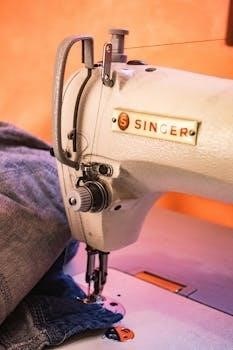
Maintenance and Troubleshooting
Proper maintenance ensures the longevity of your Kenmore 12-stitch machine. Regular cleaning and oiling are essential. Addressing common issues can prevent more serious problems. Knowing how to find replacement parts is also important for smooth operation.
Cleaning and Oiling the Machine
Regular cleaning and oiling are crucial for maintaining the smooth operation of your Kenmore 12-stitch sewing machine. Before starting, ensure the machine is unplugged. Begin by removing the needle plate and bobbin case, carefully brushing away any lint or thread buildup using a small, soft brush. Pay close attention to the feed dogs, as accumulated debris can hinder fabric feeding. Use a lint brush or a small vacuum cleaner attachment to remove any remaining particles in the machine’s interior. Next, apply a few drops of sewing machine oil to the designated oiling points, usually indicated in your user manual. These often include areas around the shuttle race, bobbin case, and other moving parts. After oiling, run the machine briefly without thread to allow the oil to distribute evenly. Wipe off any excess oil with a soft cloth. Proper cleaning and oiling will prevent jams and ensure your machine continues to perform optimally. Remember to consult your specific model’s manual for the correct procedures and oiling locations.
Troubleshooting Common Issues
Several common issues may arise with your Kenmore 12-stitch sewing machine, but many can be easily resolved. If the thread is bunching up underneath the fabric, it often indicates an issue with the upper thread tension or incorrect threading of either the upper or lower thread. Always re-thread the machine completely, ensuring that the thread is properly seated within the tension disks and through all guides. Check the bobbin for proper winding and insertion. If the machine is skipping stitches, this could mean the needle is damaged or improperly installed. Replace the needle with a new one of the correct size and type. Another common problem is the machine jamming, which is often due to accumulated lint or thread fragments. Clean the machine thoroughly, especially the bobbin area and feed dogs. If the machine is noisy, ensure that all parts are properly oiled. Refer to your manual for specific troubleshooting steps.
Finding Replacement Parts
Locating replacement parts for your Kenmore 12-stitch sewing machine is crucial for maintaining its optimal performance. The specific model number, often found on the nomenclature plate of the machine, is essential for identifying the correct parts. Sears Parts Direct is a reliable source for Kenmore parts, offering diagrams and manuals to help you find what you need. Other online retailers specializing in sewing machine parts may also carry components for vintage Kenmore models. It is important to ensure that any purchased parts are specifically designed for your model to guarantee proper fit and function. When searching for parts, be specific with your model number to avoid purchasing incorrect or incompatible parts. Additionally, consider joining online sewing forums or communities where other Kenmore users may offer advice on where to source parts, sometimes even offering compatible aftermarket parts.
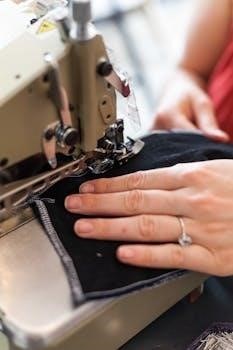
Additional Resources
Numerous resources exist for Kenmore 12 stitch sewing machine owners. Online communities, forums, and downloadable manuals can provide assistance. These resources offer guidance, support, and valuable information to enhance your sewing experience.
Online Communities and Forums
The internet hosts a wealth of online communities and forums dedicated to sewing enthusiasts, many of which feature dedicated sections or discussions about vintage and modern Kenmore sewing machines, including those with the 12-stitch capability. Platforms such as PatternReview.com offer spaces where users can share experiences, ask questions, and provide solutions to common issues, making them invaluable for both beginners and experienced sewers. These communities often have threads specifically discussing the Kenmore 12-stitch models, where you can find advice on threading, tension adjustments, and troubleshooting common problems. Members often share tips and tricks related to specific Kenmore models, and sometimes even offer scanned copies of manuals or guides that are difficult to find elsewhere. Furthermore, these forums create a supportive environment for individuals to learn from each other, share project ideas, and connect with fellow sewing enthusiasts. Whether you are looking for assistance with a specific problem or just want to connect with like-minded individuals, online communities are an excellent resource.
Kenmore Sewing Machine Manuals Online
Finding a Kenmore sewing machine manual online is often crucial for users, especially for those owning vintage models like the 12-stitch versions. Several websites offer downloadable PDF manuals for various Kenmore models, including the 385 series, which often feature the 12-stitch option. These resources are invaluable for understanding the specific functions and maintenance requirements of your machine. Websites such as Sears Parts Direct sometimes provide access to manuals for various Kenmore models, including diagrams and parts lists. Additionally, some online communities and forums mentioned earlier may also host scanned versions of manuals. These manuals often cover essential topics such as threading, bobbin winding, stitch selection, and basic troubleshooting. Having a digital copy of your manual ensures that you have all of the necessary information easily accessible. These online resources significantly simplify the process of owning and operating a Kenmore sewing machine, and are a great way to ensure proper maintenance and use of your machine.
